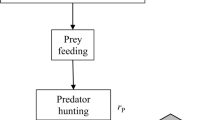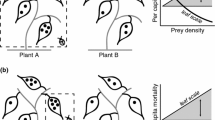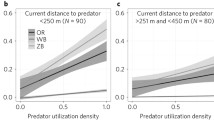Abstract
In group-forming prey species, theory assumes that individuals within groups should scan independently of one another, with vigilance sequences being relatively unpredictable, making interscan durations highly variable. We attempted to detect any divergence from randomness in the scanning process in three mammalian prey species phylogenetically and geographically separated and exposed to different levels of predation: waterbuck, Kobus ellipsiprymnus defassa, under a high observed predation risk, eastern grey kangaroo, Macropus giganteus, still experiencing occasional predation and European roe deer, Capreolus capreolus, under a very low natural predation risk. Our results revealed that the focal interscan duration increased when the duration of the preceding interscan increased, whatever the studied species and the predation risk that its individuals experienced, and decreased with the preceding scan duration in two species under, respectively, occasional and low predation risks. The exponential distribution was the tested model that fitted the observed distributions of interscan durations least well. We discuss what can trigger non-randomness in scanning, through a non-homogenous Poisson process, at both intra-individual and inter-individual levels, particularly with regard to previous studies that have demonstrated synchronisation of vigilance in such mammals. Our results suggest the need to reconsider any assumption of randomness in scanning in the basic model predicting form and frequency of scanning behaviour by prey species.


Similar content being viewed by others
References
Akaike H (1974) A new look at statistical model identification. IEEE T Automat Contr 19:716–723
Bahr DB, Bekoff M (1999) Predicting flock vigilance from simple passerine interactions: modelling with cellular automata. Anim Behav 58:831–839
Baldellou M, Henzy SP (1992) Vigilance, predator detection and the presence of surpernumerary males in vervet monkey troops. Anim Behav 43:451–461
Beauchamp G (2006) Nonrandom patterns of vigilance in flocks of the greater flamingo, Phoenicopterus ruber ruber. Anim Behav 71:593–598
Beauchamp G (2009) Sleeping gulls monitor the vigilance behaviour of their neighbours. Biol Lett 5:9–11
Bednekoff PA (1997) Mutualism among safe, selfish sentinels: a dynamic game. Am Nat 150:373–392
Bednekoff PA, Lima SL (1998a) Randomness, chaos and confusion in the study of antipredator vigilance. Trends Ecol Evol 13:284–287
Bednekoff PA, Lima SL (1998b) Re-examining safety in numbers: interactions between risk dilution and collective detection depend upon predator targeting behaviour. Proc R Soc B 265:2021–2026
Bednekoff PA, Lima SL (2002) Why are scanning patterns so variable? An overlooked question in the study of anti-predator vigilance. J Avian Biol 33:143–149
Bekoff M (1995) Vigilance, flock size, and flock geometry: information gathering by western evening grosbeaks (Aves, Fringillidae). Ethology 99:150–161
Bertram BCR (1980) Vigilance and group size in ostriches. Anim Behav 28:278–286
Burnham KP, Anderson DR (2002) Model selection and multi-model inference. A practical information-theoretic approach. Springer, New York
Caraco T (1982) Flock size and the organization of behavioural sequences in juncos. Condor 84:101–105
Clutton-Brock TH, O'Riain MJ, Brotherton PNM, Gaynor D, Kansky R, Griffin AS, Manser M (1999) Selfish sentinels in cooperative mammals. Science 284:1640–1644
Couzin ID (2006) Behavioral ecology: social organization in fission–fusion societies. Curr Biol 16:169–171
Davis JM (1975) Socially induced flight reactions in pigeons. Anim Behav 23:597–601
Deneubourg JL, Goss S (1989) Collective patterns and decision-making. Ethol Ecol Evol 1:295–311
Desportes JP, Metcalfe NB, Cézilly F, Lauvergeon G, Kervelle C (1989) Tests of the sequential randomness of vigilant behaviour using spectral analysis. Anim Behav 38:771–777
Desportes JP, Metcalfe NB, Popp JW, Meyer RM, Gallo A, Cézilly F (1990) The predictability and patterns of vigilant behaviour. Behav Proc 22:41–46
Desportes JP, Cézilly F, Metcalfe NB (1994) Vigilance patterns in birds: randomness or predictability? Anim Behav 48:226–227
De Ruiter J (1986) The influence of group size on predation scanning and foraging behaviour of wedgecapped capuchin monkeys (Cebus olivaceus). Behaviour 98:240–258
Ebensperger LA, Hurtado MJ, Ramos-Jiliberto R (2006) Vigilance and collective detection of predators in degus (Octodon degus). Ethology 112:879–887
Elgar MA (1989) Predator vigilance and group size in mammals and birds: a critical review of the empirical evidence. Biol Rev 64:13–33
Elgar MA, Burren PJ, Posen M (1984) Vigilance and perception of flock size in foraging house sparrows (Passer domesticus). Behaviour 90:215–223
Faraway JJ (2006) Extending the linear model with R. Generalized linear, mixed effects and nonparametric regression models. Chapman and Hall, London
Fernández GJ, Capurro AF, Reboreda JC (2003) Effect of group size on individual and collective vigilance in greater rheas. Ethology 109:413–425
Fernández-Juricic E, Kerr B, Bednekoff PA, Stephens DW (2004a) When are two heads better than one? Visual perception and information transfer affect vigilance coordination in foraging groups. Behav Ecol 15:898–906
Fernández-Juricic E, Siller S, Kacelnik A (2004b) Flock density, social foraging: an experiment with startlings. Behav Ecol 55:502–511
Ferriere R, Cazelles B, Cézilly F, Desportes JP (1996) Predictability and chaos in bird vigilant behaviour. Anim Behav 52:457–472
Giraldeau LA, Valone T, Templeton JJ (2002) Potential disadvantages of using socially acquired information. Phil Trans R Soc Lond B 357:1559–1566
Hart A, Lendrem DW (1984) Vigilance and scanning patterns in birds. Anim Behav 32:1216–1224
Hart BL, Hart LA, Mooring MS, Olubayo R (1992) Biological basis of grooming behaviour in antelopes: the body-size, vigilance and habitat principles. Anim Behav 44:615–631
Jackson AL, Ruxton GD (2006) Toward an individual-level understanding of vigilance: the role of social information. Behav Ecol 17:532–538
Jarman PJ (1987) Group size and activity in eastern grey kangaroos. Anim Behav 35:1044–1050
Jarman PJ, Coulson G (1989) Dynamics and adaptiveness of grouping in macropods. In: Grigg G, Jarman P, Hume I (eds) Kangaroos, wallabies and rat kangaroos. Surrey Beatty, Sydney, pp 527–548
Keverne EB, Leonard RA, Scruton DM, Young SK (1978) Visual monitoring in social groups of talapoin monkeys (Miopithecus talapoin). Anim Behav 26:933–944
Lazarus J (1979) The early warning function of flocking in birds: an experimental study with captive quelea. Anim Behav 27:855–865
Lendrem DW (1983) Predation risk and vigilance in the blue tit (Parus caeruleus). Behav Ecol Sociobiol 14:9–13
Lendrem DW, Stretch D, Metcalfe N, Jones P (1986) Scanning for predators in the purple sandpiper: a time-dependent or time-independent process? Anim Behav 32:986–993
Lima SL (1987) Vigilance while feeding and its relation to the risk of predation. J Theor Biol 124:303–316
Lima SL (1995a) Back to the basics of anti-predatory vigilance: the group size effect. Anim Behav 49:11–20
Lima SL (1995b) Collective detection of predatory attack by social foragers: fraught with ambiguity? Anim Behav 50:1097–1108
Lindsey JK (2004) Statistical analysis of stochastic processes in time. Cambridge University Press, Cambridge
Lindsey JK (2007a) Repeated: non-normal repeated measurements models. R package version 1.0. popgen.unimaas.nl/∼jlindsey/rcode.html
Lindsey JK (2007b) Gnlm: generalized nonlinear regression models. R package version 1.0. popgen.unimaas.nl/∼jlindsey/rcode.html
McGowan KJ, Woolfenden GE (1989) A sentinel system in the Florida scrub jay. Anim Behav 37:1000–1006
Parrish JK, Edelstein-Keshet L (1999) Complexity, pattern, and evolutionary trade-offs in animal aggregation. Science 284:99–101
Pays O, Jarman PJ (2008) Does sex affect both individual and collective vigilance in social mammalian herbivores: the case of the eastern grey kangaroo? Behav Ecol Sociobiol 62:757–767
Pays O, Jarman PJ, Loisel P, Gerard JF (2007a) Coordination, independence or synchronisation of individual vigilance in the eastern grey kangaroo? Anim Behav 73:595–604
Pays O, Renaud PC, Loisel P, Petit M, Gerard JF, Jarman PJ (2007b) Prey synchronize their vigilant behaviour with other group members. Proc R Soc B 274:1287–1291
Pays O, Benhamou S, Helder R, Gerard JF (2007c) The dynamics of group formation in large mammalian herbivores: an analysis in the European roe deer. Anim Behav 74:1429–1441
Pays O, Dubot AL, Jarman PJ, Loisel P, Goldizen AW (2009a) Vigilance and its complex synchrony in the red-necked pademelon, Thylogale thetis. Behav Ecol 20:22–29
Pays O, Goulard M, Blomberg SP, Goldizen AW, Sirot E, Jarman PJ (2009b) The effect of social facilitation on vigilance in eastern gray kangaroo, Macropus giganteus. Behav Ecol 20:469–477
Pulliam HR (1973) On the advantages of flocking. J Theor Biol 38:419–422
Quenette PY, Desportes JD (1992) Temporal and sequential structure of vigilance behaviour of wild boars (Sus scrofa). J Mammal 73:535–540
Reboreda JC, Fernández GJ (1997) Sexual, seasonal and group size differences in the allocation of time between vigilance and feeding in the greater rhea, Rhea americana. Ethology 103:198–207
Renaud PC (2006) Recensement aérien de la faune dans les préfectures de la région Nord de la République Centrafricaine. Rapport de mission FCT 2005. IUE/DCE, Bangui
Roberts G (1994) When to scan: an analysis of predictability in vigilance sequences using autoregression models. Anim Behav 48:579–585
Roberts G (1996a) Why individual vigilance declines as group size increases. Anim Behav 51:1077–1086
Roberts G (1996b) Testing for patterns in sequences of vigilance behaviour. Anim Behav 51:1179–1182
Rodríguez-Gironés MA, Vásquez RA (2002) Evolutionary stability of vigilance coordination among social foragers. Proc R Soc B 269:1803–1810
Rose LM, Fedigan LM (1995) Vigilance in white-faced capuchins, Cebus capucinus, in Costa Rica. Anim Behav 49:63–70
Ruxton GD (1996) Group size and anti-predator vigilance: a simple model requiring limited monitoring of other group members. Anim Behav 51:478–481
Ruxton GD, Roberts G (1999) Are vigilance sequences a consequence of intrinsic chaos or external changes? Anim Behav 57:493–495
Scannell J, Roberts G, Lazarus J (2001) Prey scan at random to evade observant predators. Proc R Soc B 268:541–547
Sirot E (2006) Social information, antipredatory vigilance and flight in bird flocks. Anim Behav 72:373–382
Sirot E, Touzalin F (2009) Coordination and synchronization of vigilance in groups of prey: the role of collective detection and predators’ preference for stragglers. Am Nat 173:47–59
Studd M, Montgomerie RD, Robertson RJ (1983) Group size and predator surveillance in foraging house sparrows (Passer domesticus). Can J Zool 61:226–231
Sullivan KA (1985) Vigilance patterns in downy woodpeckers. Anim Behav 33:328–329
Suter RB, Forrest TG (1994) Vigilance in the interpretation of spectral analyses. Anim Behav 48:224–226
Treves A (2000) Theory and method in studies of vigilance and aggregation. Anim Behav 60:711–722
Ward P (1985) Why birds do not coordinate their vigilance. J Theor Biol 114:383–385
Acknowledgements
We acknowledge M. Curkpatrick for permission to use the Newholme Field Laboratory, University of New England, Australia. We also thank all the French farmers who allowed us to conduct our field study on roe deer living on their lands near Machault, France. We are grateful to ECOFAC/PDZCV and AGRECO, in particular R. Mbitikon and F. Feys who allowed us to work on waterbuck in the Sangba base, Central African Republic. We thank A. Abdoulaye for help in filming waterbucks. We acknowledge P. Bednekoff for his helpful comments on an earlier version of our manuscript and the two anonymous referees. The University of Angers, the ‘Conseil Régional de Champagne-Ardenne’, the ‘Communauté de Communes de l’Argonne Ardennaise’ and the ‘Université Paul Sabatier, Toulouse, France’ financially contributed to this study.
Author information
Authors and Affiliations
Corresponding author
Additional information
Communicated by P. Bednekoff
Appendices
Appendix 1
The number of scans, Δn t , observed in disjoint intervals of time of fixed length Δt have independent Poisson distributions as given by:
Here, λ is the constant rate of intensity of occurrence of the scans over all time, and hence, λΔt is the average number of scans in any time period of length Δt. Because Δt may not be necessarily very small, Δn t may be greater than 1. In a homogeneous Poisson process, the durations between successive scans, the interscan intervals, are independent, each having the same exponential distribution, as given in:
where λ is the same constant intensity parameter as in the Poisson distribution of the previous equation.
Appendix 2
The gamma distribution is described by:
where μ is the mean and Φ is the shape parameter or the ratio of the mean squared to the variance. An important special case, obtained by setting Φ = 1, is the Exponential distribution. The Weibull distribution is given by
where μ is the mean and Φ is the shape parameter. Like the gamma distribution, the Weibull distribution can be reduced to an exponential distribution when Φ = 1.
Rights and permissions
About this article
Cite this article
Pays, O., Blomberg, S.P., Renaud, PC. et al. How unpredictable is the individual scanning process in socially foraging mammals?. Behav Ecol Sociobiol 64, 443–454 (2010). https://doi.org/10.1007/s00265-009-0860-0
Received:
Revised:
Accepted:
Published:
Issue Date:
DOI: https://doi.org/10.1007/s00265-009-0860-0




